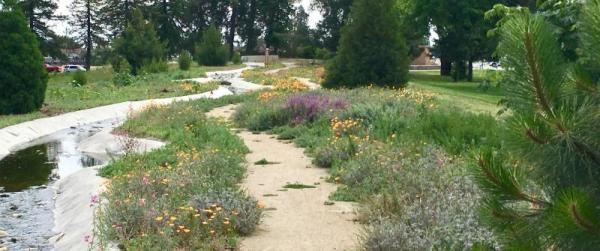About the Plant Diversity Lab
We are a group of students led by Dr. Andrew Gardner with the overall goal to study and promote the great diversity of plants in the Central Valley of California.
Our research is currently centered on two projects: A DNA barcode-based community phylogeny of our campus plants and developing methods to quantify Downingia floral shape to allow us to reconstruct floral evolution with the group.
Associated with this work, we curate the Stan State Herbarium and manage activities on the Trans-CA Pathway. We engage in regular outreach to share our work with the public.


Current Members
Andrew Gardner, Ph.D.
Assistant Professor of Botany, Department of Biological Sciences
Teaches BIOL 1150: General Biology II, BOTY 1010: Plant Biology for non-majors, BOTY 3700: Flowering plants, and BOTY 3130: Plant, algae, and fungi morphology.
Dilcia Rosas
Joined summer 2018. Biology major. Working on DNA barcoding and community phylogenetics as a STEM RISE Student Researcher. Herbarium curator.
Harmanpreet Kaur
Joined summer 2018. Biology major. Working on DNA barcoding and community phylogenetics as a STEM RISE Student Researcher. Herbarium curator.
Amanda Larson
Joined Summer 2018. Computer science major, biology minor. Web design for the lab. Data management.
Stephanie Valencia
Joined Summer 2018: Working on Downingia morphometrics as a STEM RISE Student Researcher.
Emeritus Members
Jessica Loll
Joined spring 2017: STEM RISE Student Researcher. Downingia morphometrics. Now a student at George Washington University in forensic science.
Eilbret Betsargis
Joined summer 2016: Herbarium curation as a STEM RISE Student Researcher.
Antonio Garcia
Joined fall 2016. Biology major and Supplementary Instruction leader for BIOL 1010 and 1050. His focus has been Downingia morphometrics. Planning to graduate soon and looking for graduate study opportunities.

This project encompasses many basic plant systematic activities: plant collection and herbarium curation, DNA extraction and PCR amplification, molecular sequence and phylogenetic analysis.
Our two primary goals are to construct a phylogeny of the Stan State tree species and to use the barcoding methods to help identify unknown and misidentified individuals.
We want to focus on enhancing biodiversity at Stan State, especially the representation of native species. Our tree phylogeny will also be useful in characterizing campus's overall tree diversity and to compare it with other campuses and/or protected areas.
A crucial tool for this work has been the campus tree map, which includes nearly every individual tree on campus, along with descriptions of the tree species.

About the Project
Under Construction
Page will contain information regarding the Downingia project, morphology and phylogeny, images, relevant links.

About the Herbarium
Under Construction
Add the histogram from our poster
The Stan State Herbarium is located in Naraghi Hall, room 213 (collections room).
The Stanislaus State Herbarium houses and catalogs thousands of plant specimens, with more added regularly. The extensive collection contains samples spanning decades, with some dating all the way back to the 1930s.
There are over 7500 plant specimens currently lodged and databased in the collections. Stan State students are the primary collectors and curators, working tirelessly to ensure that all specimens are properly sorted and protected so that they may benefit science now and for years to come. The collection emphasizes native plants in Stanislaus and adjacent counties, but also includes collections from across California and outside of the state.
SHTC; history? began in 1960ish by ?
There is a separate collection of just plants from the Stan State campus.
Add a pic of us making a collection, maybe another of the specimens in folders.
Our Goals
We have focused on digitizing the specimen label information, and making the herbarium more useful for students at Stan State, and more broadly.

The Trans-CA Pathway project developed from the vision of Stan State professor, Dr. Wayne Pierce. He envisioned it as a means of illustrating the native plant communities that exist along a transect from the Central Valley to the High Sierra. The Pathway is used by biology classes as an outdoor laboratory and source of material. Additionally, it serves as an educational attraction for the community as a whole, and is a field trip destination for high school students.
Members of the Plant Diversity Lab educate the public about the Pathway via outreach events such as Science Day, and through regular community cleanup days. Every other Tuesday afternoon, student volunteers help out by pulling weeds, clearing debris, planting seeds, and more.


Updated: August 08, 2023